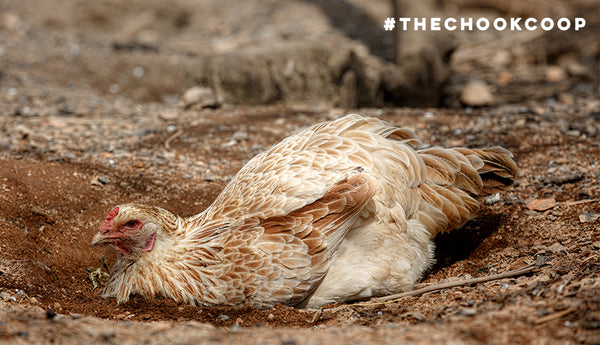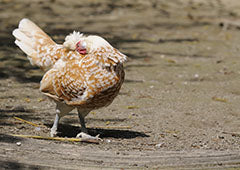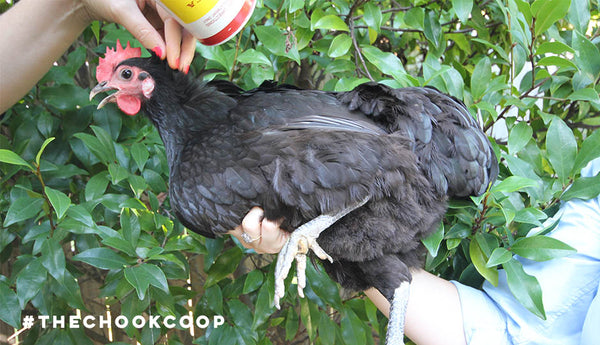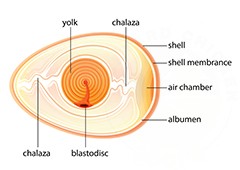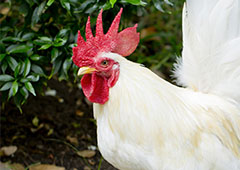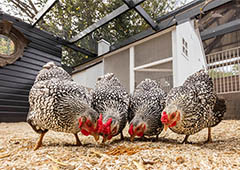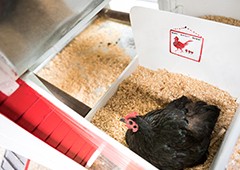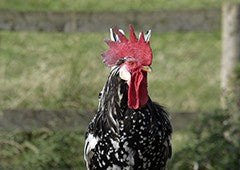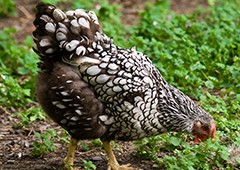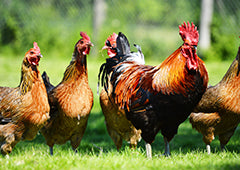Are your flock looking a little itchy? Maybe their feathers are ruffled for no reason. Mites and lice are annoying, pesky problems to have with your backyard flock, and must be treated quickly as it can spread to all the other feathered friends. For the fastest way to get rid of these pests check out our quick-fire guide. For more detailed information, we chatted to Claire Bickle, gardening and poultry expert to get the hard facts about how to get rid of these mites, should they become a problem with your chickens.
Let’s start off with some common FAQ’s about these parasites:What’s the difference between lice and mites?
Well, both are egg-stremely annoying and quite small. The difference between the two is that mites survive by feeding on the blood of your chickens. Some live on the chickens, some live in their housing and come out to feed at certain times.
Lice however do not feed on the blood - rather they survive by ingesting the skin scales and debris in their feathers. They also live their entire life on the chicken.
Both lice and mites, if left untreated, are detrimental to your chickens health, so you should definitely take action as soon as you’ve detected a problem.How are they transmitted?
Lice and mites are generally transmitted by wild birds who carry the parasites coming into contact with the coop, or your chickens. Therefore keeping an eye on critters like turkeys and other native birds is important for your flock’s health.Can they be transmitted to other animals such as my pet dog or cat?
Unfortunately there’s no definite answer as to whether lices or mites will transfer from chickens to other animals. Evidence suggests that the critters like to hang out on other mammals, so it’s worth checking your pets to see whether they’ve got a mite or lice problem. If they do, look through their bedding and their fur - if you suspect any activity, give them a good dusting and a warm bath.
Ok, now lets get into the different types of lice and mice that can affect your flock.
MITES
1. Red Mites (also known as ‘Chicken Mites’)
Red mites are some of the most common mites that affect chickens, and one of the most annoying.
Red mites are generally spread by wild birds coming into contact with your chicken coop. From here, they hide in the dark spots of the chicken coop during the day, and then come out at night to feed on your feathered friends, once again retreating when the sun comes up.
To identify whether this mite is the culprit ruffling feathers in your flock, have a close look at your chickens feathers and skin - if you can see black and red small spots, then these are most likely red mites.
How they affect your chickens:
If left untreated, the mites can cause your chickens to become anaemic. If further untreated, death may occur, so act fast!
How to prevent Red mites:
As stated previously, wild birds coming in to contact with the coop is one of the most common ways red mites can be transferred. Therefore, taking measures to prevent birds from sitting on your coop is advisable. In addition, if you are introducing new birds to the flock, quarantine them first to ensure they don’t transfer any mites to your existing feathered friends.
How to treat Red mites:
Contrary to some drastic methods, the chicken coop does not need to be burned - it will take a few treatments to get rid of all of the mites, but it will be well worth it!
- The chickens:
Ensure you are treating your chickens at night, as this is when the mites will come out from the coop and feed on the chickens. You can give them a dust of Pestene (a sulphur and rotenone powder), which should dehydrate the mites and effectively kill them (this is also harmless to the chickens). Then, you need to tackle the coop - this is what will get rid of the mites.
- The coop:
Give the chicken coop a very thorough clean - roosts, nesting boxes, the lot! Make sure you thoroughly dispose of the bedding as well, do not save it for the compost. Once the coop has been scrubbed clean, spray it with a high pressure hose, ensuring you hose out every crack and corner. Let the coop dry in the sun for a few minutes, and then give it a good spray once more.
Then, give the coop’s dark nooks and crannies a generous sprinkle with some Absorbacide (a natural insecticide) or diatomaceous earth. Make sure that when you apply these, that they do not get wet - they will not be as effective. Wearing a set of gloves and also dust masks is advisable - these powders aren’t toxic, but it is a fine powder, so might give you a sneezing fit!
Other coop treatment alternatives include Coopex, Pestene and Hydrated Lime.
2. Northern Fowl Mites
Northern Fowl mites are similar to the Red mite, in that they feed on your chickens. However, unlike the Red mite, the Northern Fowl spends its entire life on the chickens. This means that the negative effects of the mites will be faster, so it’s very important to treat them as soon as they’re detected.
How they affect your chickens:
The Northern Fowl mite will also cause anaemia in your chickens by feeding on them, and if untreated will cause death.
How to prevent Northern Fowl mites:
Keep the coop clean, and prevent wild birds and rodents from infiltrating the coop and spreading the mites. Clean up spilled feed and anything that may attract unwanted creepy crawlies!
How to treat Northern Fowl mites:
Immediately treat your chickens with a safe insecticide - try diatomaceous earth, absorbacide or Pestene. A couple of days later, treat the chickens again - this will get any remaining eggs and mites. If none of these insecticides work, contact your vet who may be able to prescribe you another poultry dust.
3. Scaly Leg Mites
These critters are so small that they can not be seen with the human eye - however, they can easily be detected by the effects they leave on your hens.
How they affect your chickens:
Scaly Leg mites weasel their way into your chickens scales on their feet, where they feed and also leave droppings. This will make your chickens legs appear scabby and crusty - and if left untreated will spread to the rest of the flock and cause them great discomfort. If left untreated for a very long time, they may cause death.
How to prevent Scaly Leg mites:
Keep the coop squeaky clean. Also quarantine any new birds you may be adding to your flock, and ensure they aren’t already affected with the mites - otherwise they may spread to your chickens.
How to treat Scaly Leg mites:
Give your chickens a nice soak in a tub of lukewarm water, and gently clean them. After they’ve dried off, dust their entire body with some Pestene or diatomaceous earth.
You will also need to give the coop a thorough cleaning - follow the coop cleaning steps for red mite, or check out our Spring Cleaning Your Coop guide for more information! (Remember to dust the coop with Pestene or diatomaceous earth).
Different types of lice:
1. ‘Shaft louse’
There is one predominant kind of lice that affects poultry in Australia, commonly referred to as ‘shaft louse’ as they rest on the chickens feather shaft. They are about 1-6mm in size, and usually a mustard colour - they also move quick. You shouldn’t have any trouble identifying lice on your chickens.
How they affect your chickens:
As mentioned earlier, shaft louse feed on the scales and feather debris of your chickens. If left untreated, they will cause a number of problems in your poor birds, such as feather pecking (you’d be pecking your feathers too if you were being bitten!), weight loss, skin irritation, a pale comb, as well as behavioural changes i.e. listless nature and a drop in egg laying production.
How to prevent Shaft Louse:
Ensure your chickens have access to a dust bathing area - this is the most effective method they have of keeping parasites off themselves. Also be wary of any wild birds that have contact with your chickens or the coop - this is how the lice (and mites) are generally transmitted.
How to treat Shaft Louse:
If you’ve found lice on your chickens, dust them with a pestene powder or diatomaceous earth. Also, dust the coop thoroughly (take care when doing this, so your chickens respiratory systems aren’t irritated). This should nix the problem. Again, ensure they have an area to dust bathe in!
Preventing lice and mites:

Catching a mite or lice problem early is the key to an easy fix - however, with a bit of patience and elbow grease you can treat lice and mites yourself.
Important tips to remember:
-
Keep the coop clean, and make sure you get all the dark corners and hidden spots.
-
Quarantine new birds and check them for any mites before introducing them to the flock.
-
Pestene/diatomaceous earth/other safe insecticides are your best friends!
-
Chickens need an area for dust bathing, even if they’re in a coop full time. This is the best prevention for lice and mites.
But wait! There is more!
As chicken keepers, we like to think that we are doing the best we can for our girls, however, there is often more we can do to prevent health issues. I recommend the Ultimate Chicken Health Course to all my readers! It is written by our friends over at Chickenpedia. They have compiled everything you need to keep healthy chickens through the seasons (which is more than you think!) with a great set of check-lists and downloads to keep.





